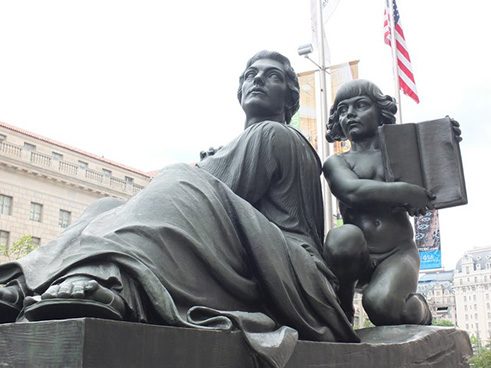Oscar S. Straus Memorial
German Roots in DC
-
The Oscar S. Straus Memorial Fountain, located in Federal Triangle on 14th Street between Constitution and Pennsylvania Avenues, NW, 2005. -
The Justice group (representing Religious Freedom). The inscription on the base reads: 'Our Liberty of Worship Is Not A Concession Nor a Privilege But An Inherent Right.', 2015. -
Plaque at Base of Memorial, 2015.
In 1854, Oscar S. Straus, then a small child, came with his mother, sister, and brothers to the United States, joining their father, Lazarus, who had emigrated in 1852. He grew up in Talbotton and Columbus, Georgia, and became one of the United States's first career diplomats, serving for many years as Ambassador to Turkey and at the International Court of Arbitration at The Hague. Later, Straus was named Secretary of Commerce and Labor under President Theodore Roosevelt. An early film from the Library of Congress shows him at work. At that time, he became the first occupant of the so-called "Pink Palace," (2600 16th Street) in Meridian Hill, now home to the Inter-American Defense Board. Straus was also a staunch proponent of American entry into the League of Nations and worked on behalf of Jewish refugees after World War I. He died in New York in 1926. Among his many writings, Oscar S. Straus was author of a book of memoirs published in 1922 entitled Under Four Administrations, from Cleveland to Taft.
Oscar S. Straus was but one of several prominent members of the Straus family. In 1874 the Strauses - Lazarus, Isidor and Nathan - opened a 25' x 100' concession in the basement of Macy's Department Store, selling china, glassware and imported items of this kind from their family business, L. Straus & Sons. In 1888 they bought part interest in Macy's, founder Rowland Hussey Macy having died in 1877 while on a business trip to Europe with Nathan Straus. By 1894 the Strauses became sole owners of Macy's. Oscar Straus's brother, Nathan, was a distinguished public health reformer and philanthropist.
Weinman's monument to Straus includes a fountain (with the words "Statesman, Author, Diplomat") and two groups of statues, "Justice" and "Reason," each accompanied by inscriptions related to these virtues.
Adolph Weinman, Sculptor and Medalist
Born in Karlsruhe in 1870, Adolph Weinman emigrated to the United States as a ten-year-old and attended public schools in New York. At 15, he was apprenticed to a sculptor and attended evening art classes at Cooper Union and, later, the Art Students League. The prominent sculptor Augustus Saint-Gaudens noted Weinman's talent and later invited the young artist to become an assistant in his studio. Weinman was also an assistant to German-American sculptor Charles Henry Niehaus. Saint-Gaudens was influential in introducing Weinman to the art world and helpful in getting the younger man commissions for various kinds of work creating sculptures and medallions. His work adorns many buildings around the country. In New York, his best known works include the pediments for the Municipal Building (McKim, Mead and White, 1907-1914), friezes for the exterior of the Morgan Library, and the bronze doors fo the American Academy and Institute of Arts and Letters.He was a member of the American Academy and Institute of Arts and Letters, the Architectural League of America, the National Academy of Design, the New York City Art Commission, and the National Sculpture Society, serving as the society's president from 1927 to 1930. He died in Port Chester, New York in 1952.
Weinman's papers are housed at the Archives of American Art.
These notes summarized from an article by Lois Goldreich Marcus in the American National Biography (1999).


